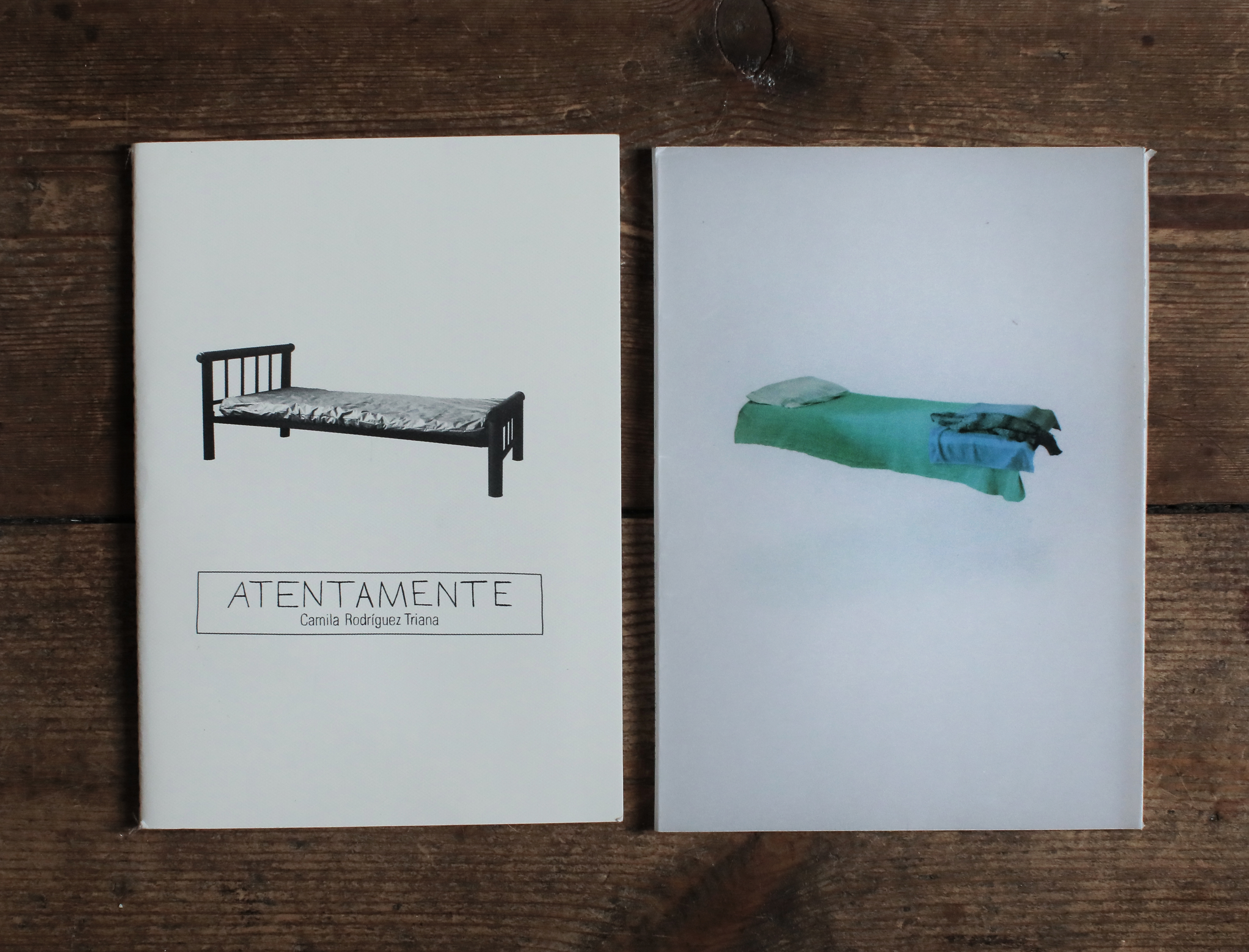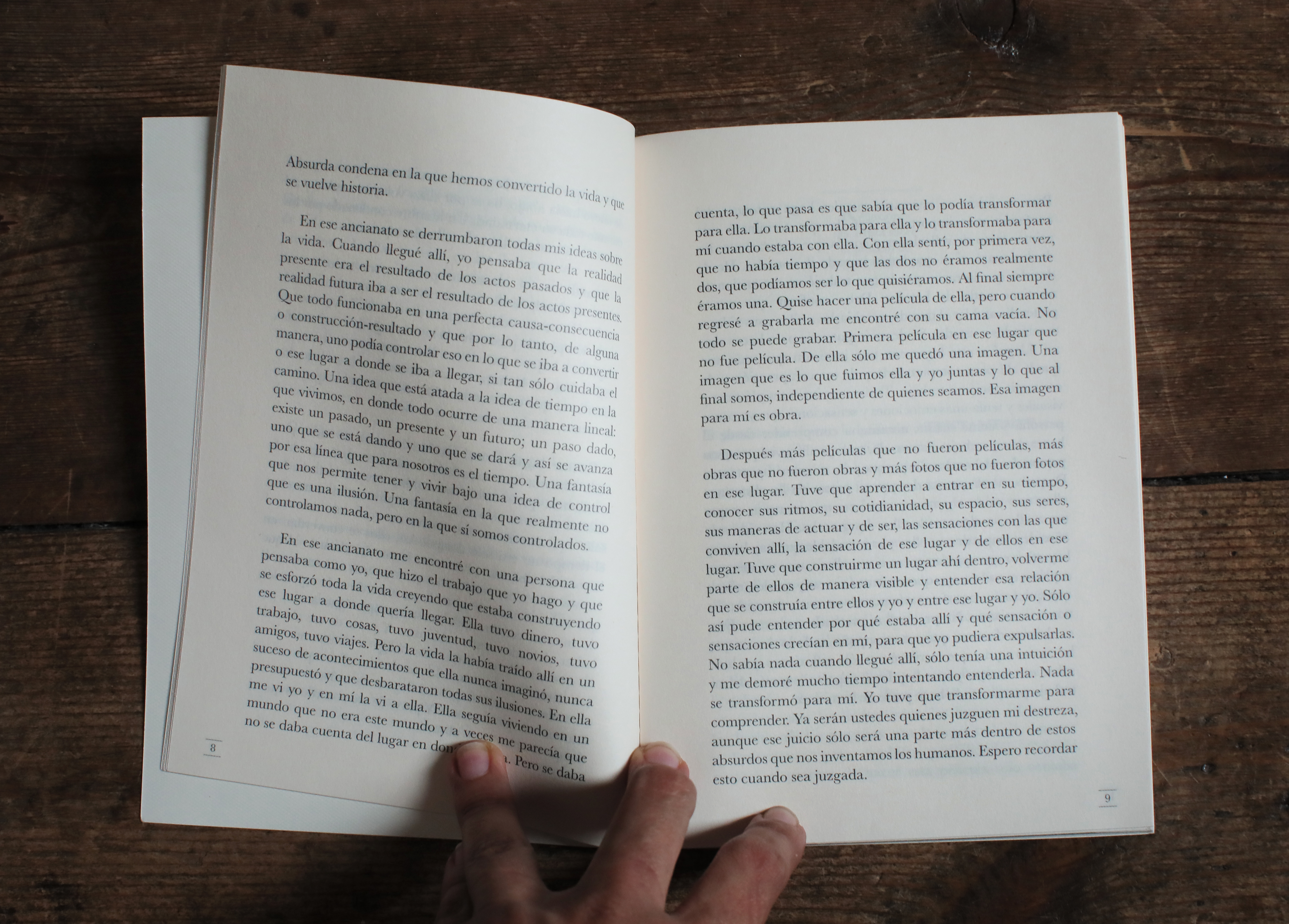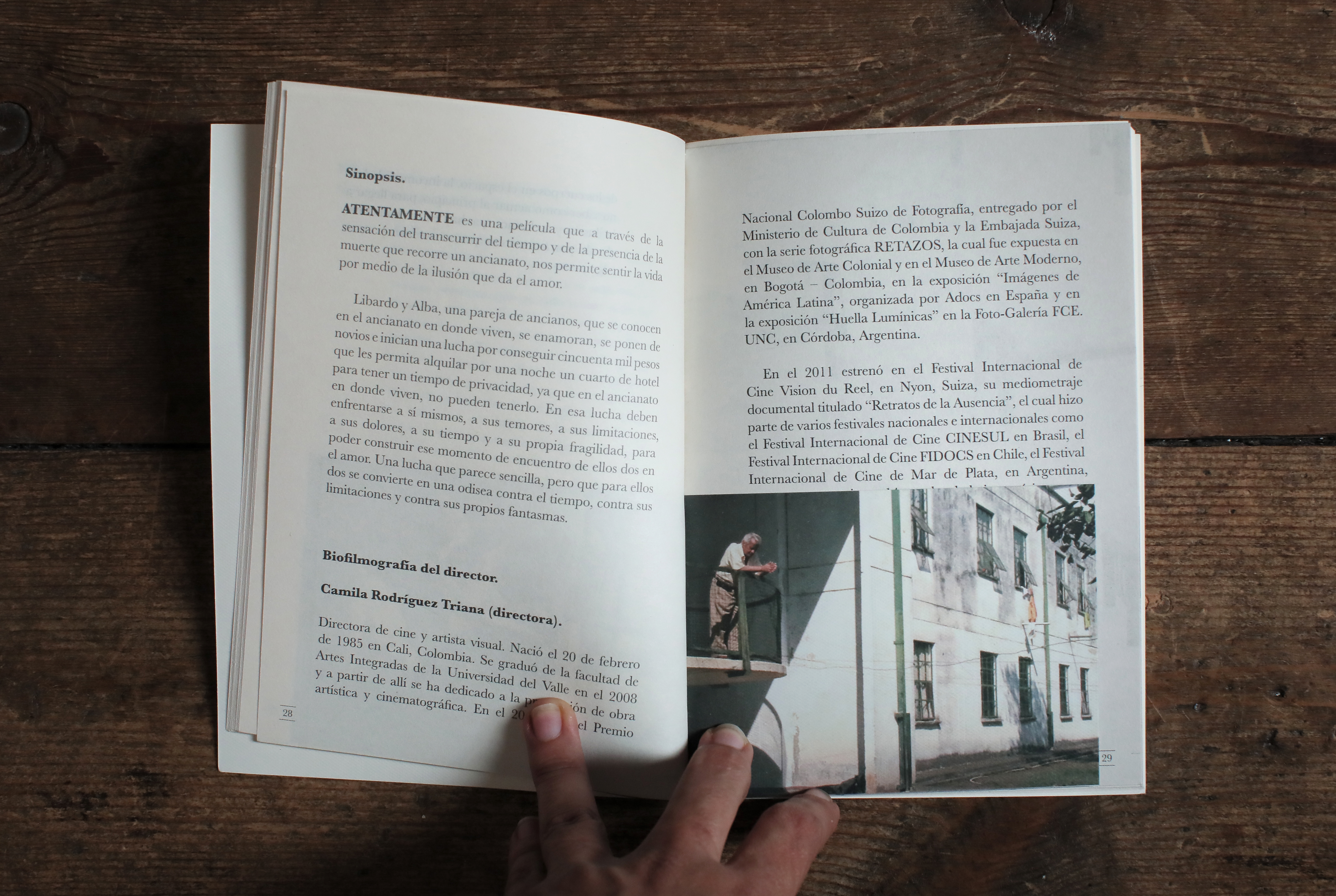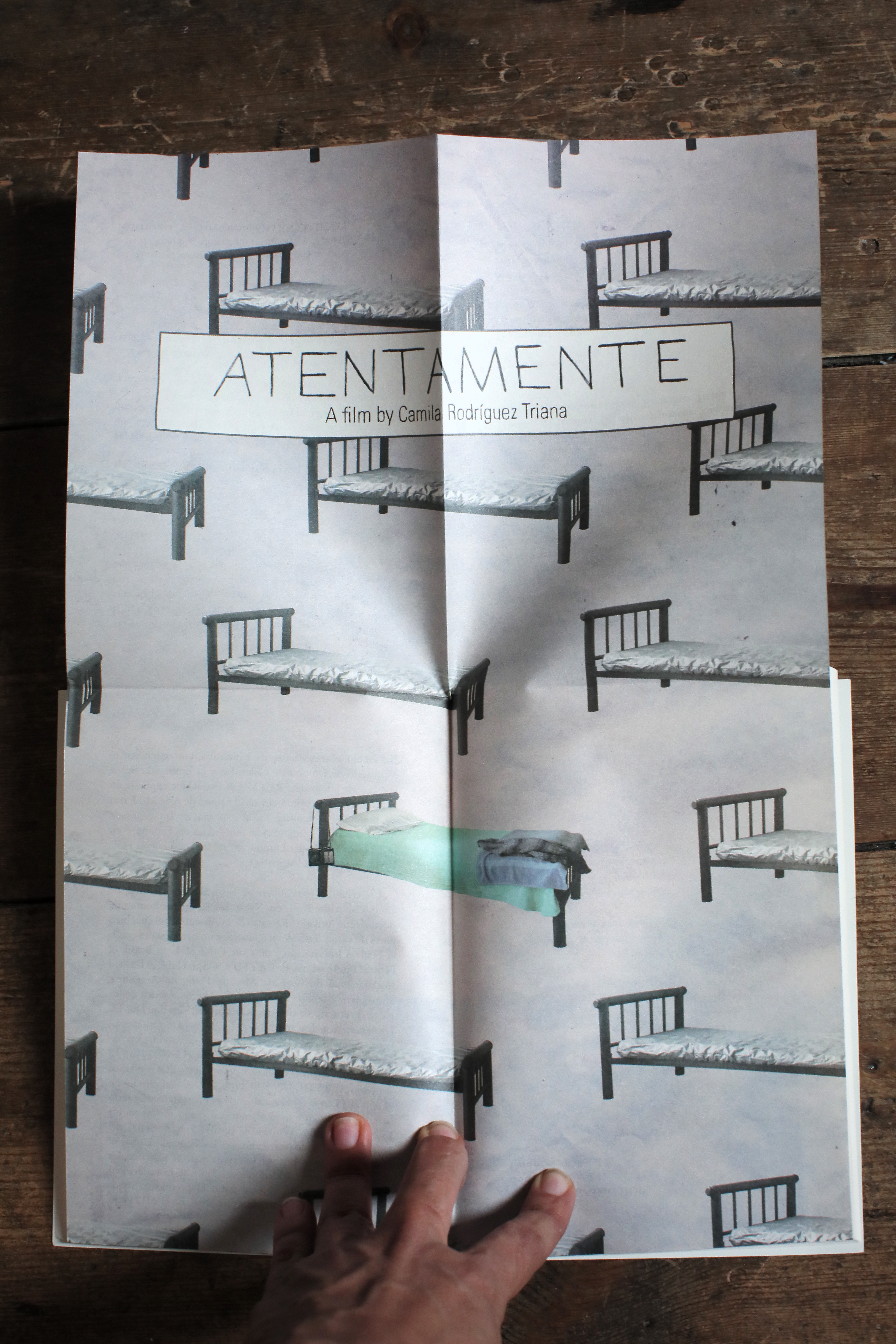Atentamente (2016)
Artist's Reflections





The process to do the film ATENTAMENTE was a process that implied a lot of time because it was hard to digest the place and the way how time goes by there. I needed time to understand the movement of this place and the way it works and how I will come inside that movement. This made change little by little my own movement so I could enter feel and understand the world of this nursing home; the way it feels and lives the world from there or what was the world that I might feel and live there. Once I entered, I felt and understood that place and those people from my perspective, I created the film, from that relation that I stablished with that world.
In this film the limits were essential to define the film itself. Not only the limits of the filming but my limits, the limits of the place and the limits of the people I worked with. Limits and limitations, but also possibilities. When I started the process to do the film I only had my intuition that I felt something important there but I did not seem to understand, but made me be there. I had my money, it was not a lot, and the support of my mom. This limitation prevented me from thinking about the possibility of transforming the place to be adequate to me or the idea or ideas I was having about what this movie could be and I quickly realized it was me who had to transform to enter that place. That limit or limitation marked the process that today I considered definitely was much more productive than the opposite process, not only because I could do this film but also because I could grow as a person and artist. One time I heard somebody say that sometimes the projects have to wait for us to be ready to make them and I think that is what happened with this film. ATENTAMENTE had to wait six years so I could be ready to make it and before this project there were many other films that were not films, but were part of my process there. I had to transform myself, I had to enter to that world, had to enter to that time, had to understand them, I had to understand and feel that place so, along with my limitations and theirs I could make the film. I Learned the schedule, the time of silence in certain place, I learned their routines, what bothered them, I learned how far I could change of their day-by-day routines, I learned to whom I could invite and to whom I couldn’t and also the way I could have these people do their best of themselves into their own limits, I filled up with the feelings that remain in that place so I eventually constructed the film. Definitely, ATENTAMENTE is a film that was born into the limits and that, like water, it started finding the way.
In the case of Alba and Libardo, who are the main characters of the film, for example I had to do a previous work very extended. It was not a work based on preparing them to be actors but it was a work for me to understand what they could give me or what they could give to this film from who they were in that moment, from their possibilities and limits, form their movements, from their stages of life in which they were, from their stories, their pains and happiness, from their tempers, their whims, their ways of reacting, so on. I had to discover what they could give in the process, because they weren’t aware at all of what they could do. But I also had to understand how I could guide them, and everyone was totally different from the other. I did rehearsals to see their reactions, to know when they were tired and to try different ways to guide them until I could find the best way that worked with each one. This knowledge that I learned about our limits in this previous work defined a lot of things of the film; the one who would be main character, how the scenes would be, how the story would be told, how could ne the sensations created, taking always into account the limits of everyone and trying to guide the possibilities I had, inside those limits.
In the process of ATENTAMENTE is always the limit of time and the fragility of life, which is the sensation of the film. Many of the movies that were not movies vanished because the person I was working with died and it was like the time that decided if that movie would be or not; the limit of times of life. And they would be films because they did not have to be films but experiences that made part of the process to get to be a film, so I could fill with sensations that later I would put in ATENTAMENTE. It was not easy at all to understand and I got some frustrations during the process. But when I felt I had understood the sensation of that place that made me be there; a sensation that was formed by the place and Libardo and Alba’s story, I knew that I had to do the film in that moment without waiting for the “ideal” conditions.
My own limits also marked the film. By the moment I did ATENTAMENTE I was having a hard time for a relationship that was over. So my look about love, in that moment, was full of nostalgia. I did a love movie, between the disillusion and that look of love, it was the film; a look of opposites. The love and the hurt of the film, to be and not to be there, the illusion and the difficulty of the reality. All in opposite way.
In this film I used the opposite to strengthen the other side of the emotion or the sensation. As for me was important the story of Alba and Libardo and that illusion, that love and that quest of privacy that is life for me, at the same way, it was important to build the opposite, which is where that love is born and what makes it more beautiful, which is the sensation present in that nursing home; the sensation of death. I wanted to build that sensation of death from an image of that place, which is not the image of a coffin or the images of death that we most know and that are related to the body, the black color or the crying. I found that mage during my process of entering in the world of that place that is related to the meaning of beds for them. The bed is the only place they consider they own, where they keep their stuff, where they decide who can sit down and who can’t, where they have their individuality. When they are alive, their beds are a reflect but when one of them dies, the bed and all the stuff is taken away and only the image of an empty bed is left, where individuality has vanished to be neutral once again, grey. For me, that neutrality reflects the death. For that reason, the image of their beds, when they are alive and when they are not, becomes very important like a metaphoric and sensitive object of what happens there, of the opposites that live there.
By the time I made ATENTAMENTE I also had thoughts and some previous questions about movies, which had an important role in the decisions I made about this film and therefore, what this film is.
I wanted to do a movie in which all the strength was set in the image and in the sound construction of such images. I wanted the images to speak more than words. For this reason, I knew from the beginning, that I wanted in this movie to have the minimum dialogue, just absolutely the necessary. From the beginning I had determined that I wanted to make the images that I had seen in that place and the sound of that place to be into this movie and to make feel what they made me feel. I did not want to sit down and tell what I had felt or have the characters tell the story through words but I wanted the construction of that place in the film could tell as it had told me at first. For this reason, any statement that wasn’t unnecessary would be out.
The only moment of the film in which the spoken word is used to tell us some situations is during the encounter of Libardo and his daughter; is that moment in which they both look at each other and they together have to face their story, after many years of absence. Despite the spoken word in that moment plays a major role, for me was essential the aspect of the body language; the way they move, the way they are seated, their looks, their reactions to each other’s movements. Their silences. That conversation and their body language in that moment tell us a story from the past from which there are no images but we only have that encounter and their memories that become into the images of the past. Through the use of words in these scenes that are different from the rest of the film, there is a contrast between two times; the present time of Libardo, who is full of silence and the past time that he has to remember and face when he meets again his daughter. from that encounter and facing what had happened and who he was, is created the possibility to make real that illusion that he has been searching for during all this film.
But my idea of ignoring everything that wasn’t entirely necessary was beyond the spoken word; I wanted all the elements that were not important to be out of the film. I wanted to believe that the essential thing would be able to transmit what I really wanted. The process of ATENTAMENTE was mainly to get rid of elements and reduce them to the minimum as well as to trust in the images based on the actions, the time, the sensation of time, the quietness and the day by day.
And based on this idea of keeping only the essential elements I made decisions about lights, the art, the music and others. For instance, in the case of the music in the films, I have always had the feeling that we have to be very careful so the music doesn’t become a way of filling the emotional and sensorial blanks of the images, a way of deceiving ourselves as directors as well as deceiving the spectators. I have always tried to avoid using music if there is not a direct connection between the story or what the movie is with that music. In the case of ATENTAMENTE, this nursing home was full of music because all the people living in there have radios on to be accompanied with. All the music in the film comes from the radios that people have on. But, since I could not use the songs they were listening to when I was filming them, because of the copyright issues, one of the other limits that I had to face, I tried to understand why everyone was listening that song and no other one. Among the people I chose to appear in the film listening to the radios, there was a direct relation among their lives, their pains, their emotions and the music they were listening to. All songs took them to an emotion or to a person related to their lives. Besides, the process of reviewing their own lives in constant in that place due to the quietness they are in most of the time. Thus, the decision I made about the songs that were composed so they could listen on the radio during the film, was that the songs were based on their own stories. All the songs on their radios talk about stories of these people, and about that process that they do when reviewing their lives form that tranquility.
In the case of light, the photograph proposal always was to work with the place as it was. We worked in the film with the natural light, also understanding the dynamic of the light as it was in there; the way the light came in in every room at a different time. That is a decision that, on one side, was made from our limits of production, but was also from a question that I had in that moment about the movies that is created and that is related to the aestheticism of the images. There are images photographically beautiful that sometimes distract spectators from the real essence in those images. I think the movies is going toward an interest of creating images aesthetically gorgeous but most of the time that construction of the image is not related to the movie itself, to the sensation of that movie and hide images full of something more than that aesthetic beauty. I wanted to quit that aestheticism of the image that somehow protects us, instead, to do images taking into account the place where we were, the sensation and texture of that place, the light of that place and the people that we portrayed.
A similar decision was made referred to the sound, which was done according to the soundscape of that place, the construction of the place and the reduction of elements until we could find the appropriate sound present in that nursing home that we wanted to be in the movie.
There is something important in this movie that I know will be commented afterwards, it is about this human necessity of classifying things in groups. Documentary or fiction? A short time ago I heard a conference by Alan Badiou, in which he talked about the conditions and characteristics of the contemporary art and one of these characteristics was the creation of hybrids, in which if really difficult to know what the thing is for sure; if it is painting or performance, performance or video, so on. I feel that the film ATENTAMENTE remains in a hybrid between the documentary and the fiction, because it has elements of both and this makes so hard to classify, at least for me. Most of the decisions I made are part of the documentary, for example: all the portrait and the treatment that I gave to the construction of what the nursing home is and the sensations as well as the time there. It is absolutely documentary in the way it is shown, the sound, the way it looks like, the way is felt that space in the film, because my job was to enter there, to understand it, feel it, explore it, to create a space for me and my team work into that place so it could be portrayed in that relationship between what that space is and my perspective. All the images of actions, of the day by day, of metaphors were born from what the place really is and what really happens there. Libardo and Alba’s story was real, it happened while I was there working in that nursing home, I saw that story while I was getting into that place and then I rebuilt it for the film, making it the most reliable to what happened but also providing my perspective to that story. For me this film lives in a limit between the documentary and the fiction that we feel and we cannot deny, it makes it really difficult, even for me, to classify this into a category that excludes the other one.
Finally, I am going to refer to the other question or concern that I have about the movies and that is related to the relation between the production work and the creativity that imply to make a film that, from my perspective, it is contradictory a lot. I feel that the process of production of a film as it is stablished in the “industrial” model is very inscrutable and this creates a direct contradiction with the creative work. It is produced thinking about the money and this is already a contradiction if we think the movies is art. For example, the very close division of the stages when doing a film, writing, pre-production, filming, editing, so on, it is absurd from the creative viewpoint, because almost always the director is denied to be able to go back to remake images or things that he realized were not completely ready at the editing stage. I think that we have to understand that in the creative work it is necessary to try and be wrong to find the way. Otherwise, we are forcing the director to wear himself a straitjacket. I think that we have to recognize that in the creative process everything is transformed and changes so I consider that hermeticism that exists with the script, the filming or with the budget sometimes is absurd. That hermeticism in the system of production is contradictory not only with the art but with life itself. In the case of ATENTAMENTE, the system of production was receptive to the creative work and the writing stages, filming and editing were made simultaneously; I went to film, checked those images at home and based on that I knew I had to film again, the images and my relation with them was what depicted the path toward this film. I always could go back; I always could try other ways but I could only know this when I saw the images that I had and started to construct the film in my computer and in my mind. Form that part, I wrote and went back to that place and worked on what I had from those images. I don’t quite know whether ATENTAMENTE is a masterpiece, that will be told by the time and by people but as for me, as artist and director was fundamental to be able to work in this way and to have the freedom to look, listen and feel the images that I myself was doing, because I had the possibility to understand what I was doing from the images, from the material produced by the work and I think that having that opportunity is essential for the creative work.
Year of publication: 2016
ISBN:978-958-46-9838-4
Textos y fotografías: Camila Rodríguez Triana
Editor y corrector de estilo: María Juliana Soto
Traducción al inglés: Mauricio Monroy
Diseño y diagramación: Johnattan Ríos